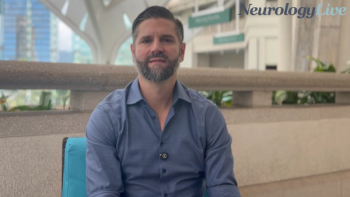
Short-Term Dosing Regimen Gives Cladribine an Advantage in MS

Kottil Rammohan, MD, director of the MS Division and Multiple Sclerosis Center of Excellence at the University of Miami, discussed the EMD Serono agent’s history and advantages for the patient community.
Kottil Rammohan, MD
In mid-2019, cladribine (Mavenclad; EMD Serono) was approved as an
It was approved based on the data from a trial including more than 1300 patients with relapsing forms of MS, ultimately showing a significant decrease in the number of relapses experienced by patients who had ≥1 relapse in the previous year, compared to placebo. Its unique dosing regimen has offered patients a more convenient method of medication administration, and up to 10 years of data from its clinical development program, consisting of the CLARITY (NCT00213135), CLARITY-EXT (NCT00641537), ORACLE-MS (NCT00725985), and PREMIERE (NCT01013350) studies.
To find out more about how cladribine got to this point and what it offers the MS patient community, NeurologyLive spoke with Kottil Rammohan, MD, professor of clinical neurology, and director, MS Division and Multiple Sclerosis Center of Excellence,
NeurologyLive: Could you provide a brief overview of how cladribine got to this point through its development?
Kottil Rammohan, MD: It was after the discovery of the cause for the bubble babies who are born immunodeficient. And when those children were studied, what was found was they were perfectly normal in every way, except they had no lymphocytes. The lymphocytes were severely, severely depleted. Then the enzyme that was the basis of that abnormality was discovered to be adenosine deaminase—ADA—and adenosine deaminase deficiency led to the severe lymphopenia that was seen in these patients.
That gave the idea for Ernie Bueller and his colleagues at Scripps to potentially utilize this as a mechanism to deplete lymphocytes—they were looking mainly for hematological and oncological reasons to do it—and what they did was to put a chlorine molecule on deoxyadenosine and that literally recreated the ADA deficiency that was seen in these children. The molecule had the ability to be toxic to lymphocytes, and the beauty of it was that you could adjust the dose and control the lymphopenia. That was the beginning of cladribine, and cladribine became the drug of choice for hairy cell leukemia, a type of leukemia in which it was extremely effective, and then people started looking at the lymphocyte as a target for a variety of autoimmune disorders, including multiple sclerosis. The story goes that Ernie Bueller’s sister, who had multiple sclerosis, was treated by Jack Sipe from Scripps. It was an IV formulation—nobody knew the dose to use at the time—so a very large dose was used. But it clearly was effective in controlling progression of MS, and that led to a whole series of trials of the IV formulation until the tablet was discovered.
The tablet is about 40% efficient compared to the IV formulation. The dose is 60% more, so the comparable dose tablet will achieve the same thing as the IV formulation. So, it was very convenient. The drug has a very short half-life, but in the time that is it is in the body, it goes after the lymphocytes, so the effect of the drug is long-lasting. Even though the half-life is only a few hours, the drug has a lasting effect on producing lymphocyte depletion.
Could you provide a brief overview of the CLARITY study and its extension?
The trial in MS was designed and the and that trial was going to be the first pill for multiple sclerosis because you look at the landscape of MS treatment at the time that the CLARITY trial was launched, you will notice that the treatments we had were the interferons—3 interferons—and Copaxone. We had nothing but the injectables, and the FDA gave it fast track of getting approval early.
The trial was completed, and in this trial, there were 2 doses of cladribine that were used: 3.5 mg/kg and 5.25 mg/kg. Both of these doses were tested, and the 2-year trial was completed, and—fortunately, or unfortunately—there was no extension planned, so a lot of the people who completed the core trial were without any other additional treatment, which turned out to be actually a useful piece of information. When the core part of the trial was completed, a lot of patients finished their trial and there was no extension to go into. But nobody started another disease-modifying therapy because they were doing really well. That's how we really found out that the effect of the drug is long-lasting. It had a durability of effect that was unexpected.
The other good thing about the CLARITY extension was that for the first time—we had never done it before—we randomized patients who are on treatment with cladribine to either stay on treatment with cladribine or to go on a placebo. That was to find out how long can one go without retreatment. What became clear, with both the lapse in going into the extension immediately and also about the extension, was this drug has a durability of effect that was unexpected. What that tells us is that this is not a drug that is going after activated lymphocyte, it is it takes resting lymphocytes and activated lymphocytes and it gets the memory cells. The memory B cells and T cells are depleted, so when new cells are repopulated by the bone marrow, they are not autoreactive cells, they are normal cells. You have eliminated the autoreactive cells for at least a brief period of time—we don't really know how long that period of time is.
When the drug was approved, it was approved to be given 5 days a week in the first week, and then 4 weeks later they get the next 5 days, and then nothing for a year. Then the 2 cycles are repeated a year later, and that's it. That's the recommendation, that we do not give more than the 2 cycles. When we do the 2 cycles, the patients go through lymphopenia, and then they recover from the lymphopenia. What looked like something that was unacceptable at the time that this trial was done is now readily acceptable because there are other drugs that cause even more lymphopenia than what this drug does. The Grade III, Grade IV lymphopenia is only 1% of the patients—most patients go through Grade I and Grade II, which is totally acceptable. We never really found any dreadful infectious complications because of the lymphopenia. No cases of PML occurred with this drug. Although, it is important to monitor for it in the long haul and the post-marketing scenario.
Has any of the recent data that’s been presented on cladribine stood out to you?
One of the posters at ACTRIMS 2020, in particular, about this study was a post hoc analysis of that group that went after the trial on cladribine versus placebo. We have now 4 years. The first 2 years were the core part of the study, the next 2 years was the extension. In the extension, you had patients who were initially on cladribine that's now randomized to placebo, or initially on cladribine who are remaining on cladribine. When you look at the annualized relapse rate or exacerbation-free patients, it was about 70% to 80% of patients. That number was the same whether you retreated them in year 3 or year 4 versus whether you just put them on placebo afterward. Essentially, what it's telling us is 2 years of treatment is adequate, and 3.5 mg/kg is adequate compared to 5.25 mg/kg because the 5.25 mg/kg did not offer any benefits more than the 3.5 mg/kg, and the lymphopenia was even more severe in the 5.25 mg/kg group compared to the 3.5 mg/kg group.
This is a drug that is novel. And it's novel not only because it's an oral formulation, but it's a new concept in the treatment of MS. That concept is that we do not need to keep giving a disease-modifying agent through the lifetime of the patient because every treatment that we use today is literally, once you start, you don't stop. They keep going on the drug. But this is 1 drug that you give for 2 years, just like Lemtrada. You give it for 2 years, and it resets the immune system—if that's what you want to call it. The autoreactive cells are no longer at sufficient numbers to cause issues, and what is recommended that we do is basically just follow the patients year after year after year, clinically and by MRI. It's possible that some patients may breakthrough and reactivate the disease, at which point either you will re-treat. If that's what you're going to do, you're in unchartered waters because there is really no data on re-treatment at year 3 or year 4.
What is the impact of this dosing regimen being the way it is?
It's huge. I mean, from a patient standpoint, once they invest in the initial 5 days, and then the second 5 days, their commitment for a year is over. A year later, you commit yourself for another 5 days and another 5 days, and that's the end of the treatment. To be able to do that and not to have to worry about, “Did I miss my drug? Did I take it?” You can go on vacation. You can leave your home for 6 months or even a year and you don't have any problems. That convenience for them is really, really big.
I have patients from the Bahamas and the Caribbean and the islands, and they don't have large medical care over there. They come to the University of Miami and we are the sort of a hub for medical care for those patients. They used to come once a month to get their Tysabri or every 6 months for their service. A number of them have moved onto cladribine and are very, very happy. When they take the tablet, they literally feel nothing. I mean, it's like taking an aspirin pill. You don't have any side effects—no nausea, vomiting, hair loss, nothing because it doesn't have an effect in the doses that we administer on any other organ other than the lymphoid system.
Once that commitment is over, their life is theirs, and it's such a relief. They were spending a significant amount of time, effort, and money to come to Miami to receive their care. And it's not just that population—I think any patient anywhere has the benefit of a short commitment to the treatment and a long-lasting possibility to offer relief. If you look at NEDA, no evidence of disease activity, it's pretty impressive how many patients—almost half the patients—who go on the drug are in the NEDA state at 2 years. Very few drugs can claim that. That's another attractive thing about this drug. It improves patient quality of life enormously.
Transcript edited for clarity.
Newsletter
Keep your finger on the pulse of neurology—subscribe to NeurologyLive for expert interviews, new data, and breakthrough treatment updates.









































